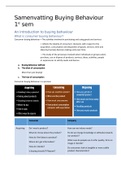Samenvatting Buying Behaviour
1e sem
An introduction to buying behaviour
What is consumer buying behaviour?
Consumer buying behaviour = The activities involved in purchasing and using goods and services
= reflects the totality of consumers’ decisions with respect to the
acquisition, consumption and disposition of goods, services, time and
ideas by (human) decision-making units over time.
= The study of the processes involved when individuals or groups select,
purchase, use or dispose of products, services, ideas, activities, people
or experiences to satisfy needs and desires.
a. Buying behaviour defined
b. The what of consumption
More than just buying!
c. The how of consumption
Consumer buying behaviour is a process:
Consumer Company
Acquiring Do I need a product? How can we induce needs?
What do I know about the product? Ho do we change knowledge or attitudes towards
our product?
How do I feel about a product?
What cues do people use to infer quality, form an
Where do I get information?
image or decide?
How do I decide?
Do consumers look at tangible or more subtle
Is buying stressful? Pleasant? product characteristics?
, How can we make the store experience pleasant?
Consuming What does the product say about me? What image do we want to have?
How much will I consume? How can we increase volumes?
Disposing Am I satisfied with the product? How can we facilitate positive WOM?
How do I dispose of the product? How can we help dissatisfied consumers?
Consumption is more cyclical than sequential.
Acquisition -> consumption -> disposal -> evaluation -> exposure -> beliefs
Table – different types of behaviour:
BEHAVIOR DOMAIN OBSERVABILITY DESCRIPTION
OVERT Physical Actions By Individuals and Others What You Do
(External)
VERBAL Spoken or Written By Individual and Others What You Say or Write
words (External)
COGNITIV Mental Thoughts By Individual Alone How You Decide What to Do and
E Say
(Internal)
Important concepts in the how of consumption:
Perception
Memory
Attitudes
Decision making
d. The who of consumption
Consumer behaviour does not necessarily reflect on the action of a single individual. Combinations of
people may be involved in a purchase: a group of friends, coworkers, a family. Different people may
play different roles: buyer/ end user/ influencer.
,Consumer trends 2021: health conscious & safety, mental health, community driven, flexibility, back
to basics & value, availability & convenience, eco-friendly, shopping online, at home entertainment
(online), local leisure, local stores, brand switching.
Te kennen leerstof (seminar: retail): Source: The great consumer shift: Ten charts that show how US
shopping behavior is changing | McKinsey; Ten charts show how COVID-19 is affecting consumers in
Europe | McKinsey
e. The why of consumption
Brand images, brand personalities created by product advertising, packaging, branding, positioning,
market segmentation strategies and often influenced by county of origin.
f. The when and where of consumption
Role theory: consumer behaviour resembles actions/roles in plays -> modify decisions by adapting
evaluation criteria.
Groups: consumption communities, reference groups
Situation: place in store, behavioural economics.
g. External and internal influences
h. Evolving consumer research
Consumer research concepts:
Past 60’s Past 80’s Present Future
I➔C➔A➔B➔S Behavioural Customer journey How to deal with crisis?
economics
MAAM Experiential view See previous concepts AI
through technological lens
Social cognition frameworks Same topics, different methods
Interdisciplinary Influences from many different perspectives/fields: Marketing, Psychology,
Sociology, anthropology, neuroscience, economics, statistics.
, Consumer research methods:
Past 60’s Past 80’s Present Future
Experimental lab studies RCT Lab studies, Online Replicability
studies (panels),
Surveys Decision strategies Secondary data, Neuro-
Measuring, weighing, Behavioural marketing techniques,
combining beliefs outcomes Large field studies
Quantitative analyses: Qualitative, AI, machine learning, VR,
multivariate statistics, Interpretive, Big data, Field studies,
structural equation Ethnographic, Data analyses software,
models, multidimensional Humanistic, Text mining, Data mining
scaling, conjoint analysis, Introspective for image and sound
and other mathematically
sophisticated techniques
methodological
transparency, open access
to data and materials, and
study pre-registration
Consumer research aims:
Past 60’s Past 80’s Present Future
Implications for To understand Help companies, policies and Increase relevance
marketing managers consumer behavior consumers and reliablity
Theoretical insights Theoretical contributions
Managerial relevance The ‘new’ consumer
Ethicality, sustainability, social
equality
Recap:
Different definitions, more than just buying. A cyclical process including different types of behaviour.
More than individual consumers. Evolving motivations, goals & needs instead of individuals.
Situational dependency. Internal and external influencing variables, consumer research concepts,
methods and aims are constantly evolving.
Why study consumer buying behaviour?
a. Who benefits?




